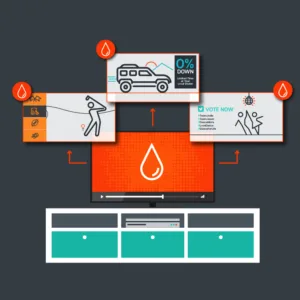NextGen TV, also known as ATSC 3.0, is a major upgrade to the existing broadcast television standard in the United States. The technology promises to deliver a wide range of new features and capabilities to viewers, including improved picture and sound quality, support for 4K and HDR content, better reception in areas with weak signals, and interactive features such as on-screen guides and personalized content recommendations.
However, what really sets NextGen TV apart is its IP-based transmission, which provides better flexibility and interactivity. The technology allows broadcasters to deliver targeted and personalized content to specific viewers or groups of viewers. Additionally, NextGen TV can gather more precise measurement and analysis of audience engagement, enabling broadcasters and advertisers to create more effective content and campaigns.
Another significant advantage of NextGen TV is its ability to support a range of new applications, such as emergency alerts, targeted advertising, and mobile TV viewing on smartphones and tablets. These features will enhance the overall TV experience and offer viewers more control and convenience.
Despite its many advantages, the adoption of NextGen TV has been slow, with only a few major cities currently offering the service. One of the main challenges is the need for broadcasters and TV manufacturers to upgrade their infrastructure and equipment, which can be costly and time-consuming. We have seen some movement forward, and at NAB 2023, we are seeing some firm commitments to NextGen tech. One such announcement is from Verance.
Getting the Band Together: Verance’s Aspect Watermark Technology
Verance’s Aspect watermark technology is an implementation of the ATSC open watermarking standards that promises to help accelerate the adoption and success of NextGen TV. Verance just announced adoption by a major broadcasting group consisting of Sinclair Broadcast Group, Gray Television, Graham Media Group, and Capitol Broadcasting Company. The Verance Aspect audio watermark will be implemented on their stations to enhance the capabilities of NextGen Broadcast applications. Interestingly enough, Sinclair Broadcast Group plans to build a broadcast platform that will provide a wireless broadcast backbone for IP data delivery across the United States using NextGen broadcast network technology, a data delivery as a service (DDaaS) platform. It is designed to serve many diverse use cases, including large-scale software updates, data off-loading from traditional unicast cellular service, and emergency information services, among others.
The Verance Aspect watermark is designed to carry metadata and triggers associated with NextGen experiences, launching broadcast applications through all distribution paths, including ATSC 1.0 over-the-air, ATSC 3.0 over-the-air, cable/satellite, and over-the-top services. As such, the combination of watermark technology and DDaaS is essentially all the foundation you need to create some compelling applications for NextGen TV. Verance believes that its watermark technology addresses the limitations of NextGen TV adoption by reaching 100% of connected televisions. The company believes that without the Verance Aspect watermark, up to 80% of households would be unable to receive NextGen capabilities.
Verance has been around for over 20 years and has been a leader in audio watermarking technology since its inception. The company was founded in 1999 and has since developed a range of audio watermarking technologies that are used in various industries, including broadcast television, music, and film.
One of Verance’s most notable accomplishments is its development of the Cinavia watermark, which is used to protect copyrighted content in the film industry. The Cinavia watermark is designed to prevent illegal copying and distribution of movies and has been adopted by major studios like Sony Pictures and Warner Bros.
In recent years, Verance has shifted its focus to developing audio watermarking technologies for the broadcast television industry, specifically for the NextGen TV standard (ATSC 3.0). Some of Verance’s competitors in the audio watermarking space include Digimarc, Civolution (now part of Nagra), and Audio Watermarking Tools offer similar technologies that allow broadcasters and other content providers to deliver interactive and personalized content to viewers. However, Verance’s long history and proven track record in developing audio watermarking technologies for various industries, as well as its wins among proponents of ATSC 3.0, give it a competitive advantage in the market. Verance’s partnership with major Sinclair, Gray, Graham Media, and Capitol Broadcasting helps to solidify its position as a leader in the industry.

